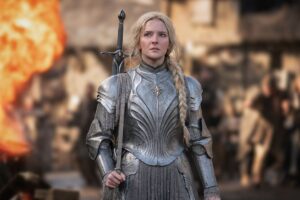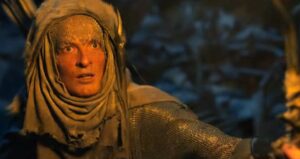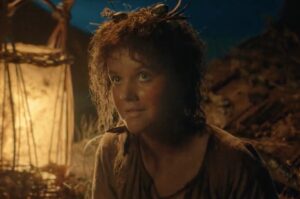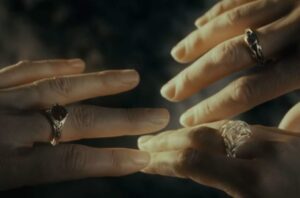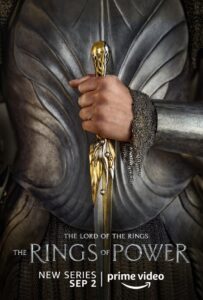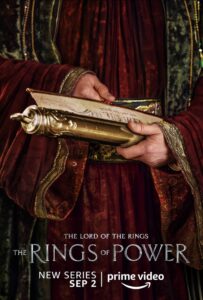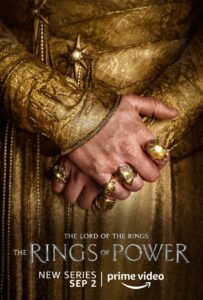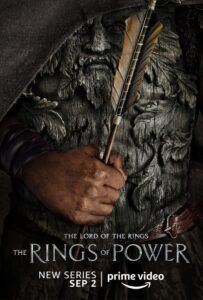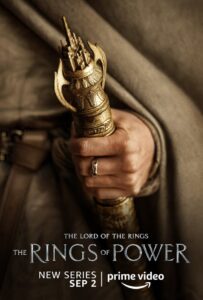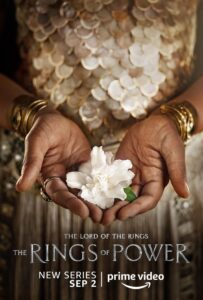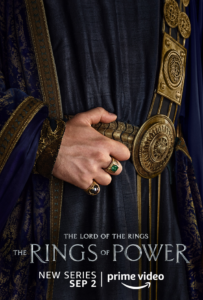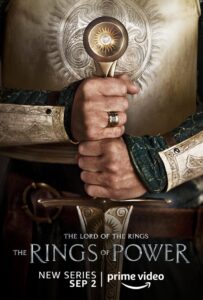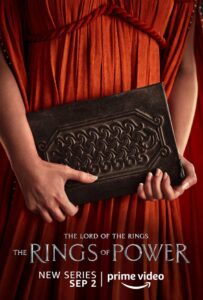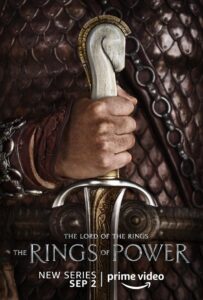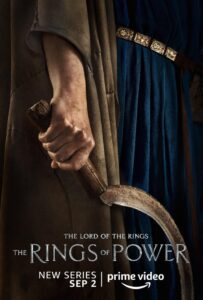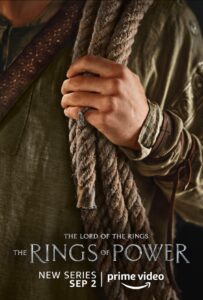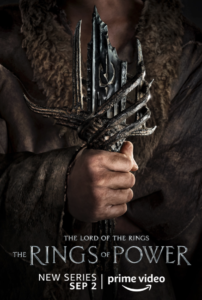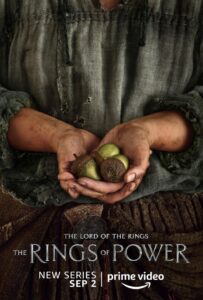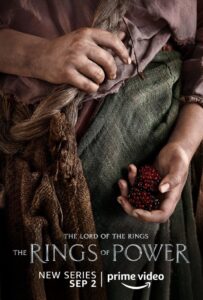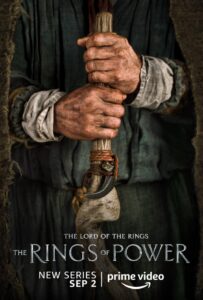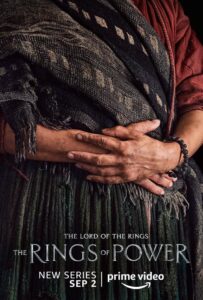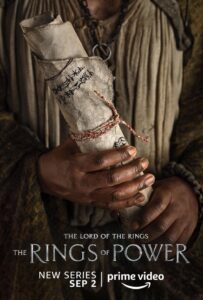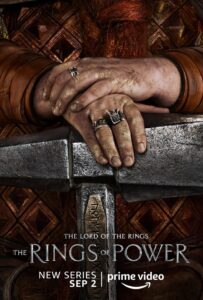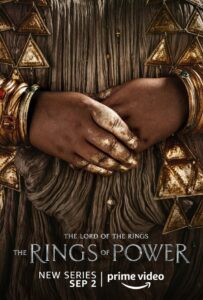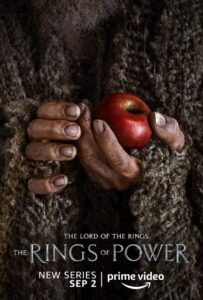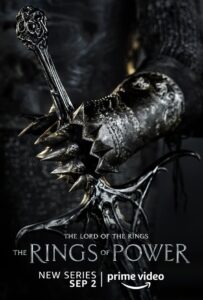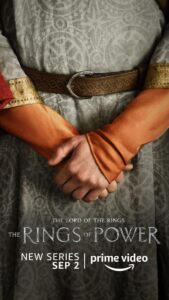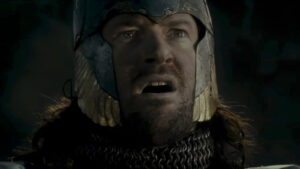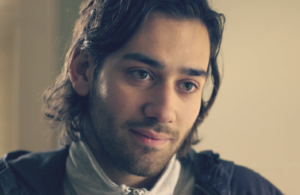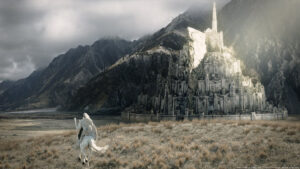Middle-earth has been described by some literary critics as a living, breathing character in the writings of J.R.R. Tolkien and in every adaptation of said writings, one as vividly realized and as crucial to the great tales as Gandalf, Galadriel, Aragorn, or either of the Bagginses; perhaps even more so than any of those characters, as Middle-earth is the sphere in which all of the great tales unfold (well, disc-turned-sphere…long story, we’ll get to that). No character undergoes as much radical development throughout the story as Middle-earth itself, which is altered irrevocably – though sometimes subtly – every time an Age of Middle-earth ends and a new one begins. Tolkien postulated that, sometime long after the events of The Lord Of The Rings, Middle-earth’s history would naturally segue into ancient human history, meaning that Middle-earth is our earth and continues to be a character in our modern-day “great tales”.

But of course, the version of Middle-earth in which we currently reside hardly resembles the one depicted on most maps of Middle-earth (tucked into most editions of The Lord Of The Rings right between the index and the back cover, which makes it frustratingly inaccessible to readers until after they’ve finished the book), and that version of Middle-earth bears as many distinct differences as it does similarities to the version of Middle-earth described in the written records of the Second Age, which ended roughly three-thousand years before the events of The Lord Of The Rings…the version of Middle-earth that will star in Amazon’s The Rings Of Power, a story of complex human drama immediately preceding the War of the Last Alliance in which the Second Age came to a sudden end.
As the title of today’s post makes clear, this is a travel-guide to Middle-earth of the mid to late Second Age – one which I hope you will bookmark for future reference, so that you never get confused while watching The Rings Of Power. I’ll briefly go over the histories of each new location in season one up to the point where the story opens, and in most cases no further than that, so you won’t get spoiled for events in future seasons if you don’t want to be.
But first, a couple things to keep in mind regarding this version of Middle-earth. When The Rings Of Power opens, Middle-earth is only just starting to heal after centuries of war and its inhabitants are almost single-mindedly focused on rebuilding everything they sacrificed at the end of the First Age to achieve that peace…although a sizable chunk of Middle-earth (encompassing the Elven kingdoms of Gondolin, Nargothrond, and Doriath) is lost forever beneath the seas, having been “rent asunder” by gods and dragons during the War of Wrath. The gods have long ago departed Middle-earth without fixing any of the damage they caused, leaving many Elves, Dwarves, and humans displaced in the wilderness.
Also, the world is canonically flat throughout most of the Second Age. I know, I know, it sounds like such a big deal – but honestly, it’s surprisingly irrelevant. The only instance in which I could see it being brought up in The Rings Of Power is if the characters travel into the furthest eastern, southern, or northern regions of Middle-earth where the sea and land presumably just stops and the void begins (Tolkien was helpfully nonspecific about how any of it worked). Traveling west past the island of Númenor would eventually yield the same result, but is strictly forbidden to all save the Elves; for in that direction lies Valinor, the Undying Lands of the gods. And that is, incidentally, where we start our journey around Middle-earth…
Tirion

The paradisiacal region of Valinor was once home to the Noldor, High Elves with an innate passion for exerting their mental and bodily capacities to create great works of art. The Rings Of Power looks back to these days of innocence (which some might call ignorance) when the Noldor built a tall and many-towered city named Tirion in the Cleft of Light that cut through the mountains surrounding Valinor, allowing the soft glow of the Two Trees to escape the blessed land and spill out over the ocean. Here, under the leadership of King Finwë, dwelt the three princes of the Noldor, Fëanor, Fingolfin, and Finarfin, and their individual families – including Fëanor’s seven mighty sons, and Finarfin’s daughter, Galadriel.
Sadly, I doubt we’ll spend much time in Tirion outside of a few vague flashbacks establishing Galadriel’s origins and her close relationship with her brother Finrod – Amazon literally can’t go into too much detail regarding any of the characters who make up her extended family without straying into territory covered by The Silmarillion; the rights to which are currently being withheld by the Tolkien Estate. But that’s okay. By the beginning of the Second Age, the only character still living in Tirion worth mentioning by name would be Finarfin, one of a handful of Noldor Elves who didn’t leave Valinor to pursue Morgoth into Middle-earth after the Dark Lord stole the light of the Two Trees.
Forodwaith
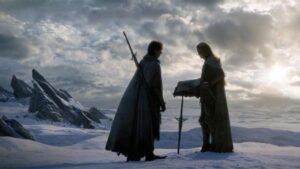
The vast northern expanses of Middle-earth, between the Grey Mountains and the edge of the world, are a cold and forbidding place unlikely to ever heal from the grievous wounds inflicted upon the land in ages long past by the Dark Lord Morgoth, who built two great underground fortresses, Utumno and Angband, at either end of the Northern Waste and traveled between them frequently until Utumno was destroyed and he was forced to retreat to Angband, where his lieutenant Sauron awaited his arrival. Together, they erected three hollow mountains above the gates of Angband, which issued poisonous gases and foul smoke to burn and degrade the land around Angband for many miles.
During the War of Wrath, dragons falling out of the sky crashed into Angband and destroyed its fortifications, allowing the gods to storm in and capture both Morgoth (whom they promptly tossed into the void, never to be seen or heard from again) and Sauron (whom they offered a pardon, which he refused before fleeing into the east). The remnants of Morgoth’s armies, including orcs, trolls, dragons, and even a couple of Balrogs dispersed across the Northern Waste, and those that did not succumb to the bitter cold and toxicity of the air burrowed into the ground and hid or at last entered Middle-earth and found strange new lands to defile with their presence.
Early in The Rings Of Power season one, Galadriel leads an expedition into the Waste to hunt for traces of Sauron (I’m interested to know whether she’s following a lead or trusting her intuition), and encounters a ferocious ice-troll dwelling in the ruins of a fortress – not Angband, but one of its outposts, I’m sure. She also discovers the mark of the Lidless Eye burned into a room with dead orcs trapped in its walls like flies in amber, implying that Sauron did in fact pass through the fortress on his way out of Angband, although whether he stopped to recruit some orcs in a ritual-gone-terribly-wrong or was ambushed by them is unclear at present.
Lindon
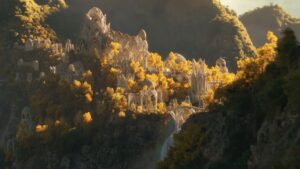
A thin sliver of the old country that had crashed into the sea during the War of Wrath, Lindon in the early Second Age became a haven for displaced Noldor Elves, Silvan Elves, and Dwarves whose cities beneath the Blue Mountains had caved in, all gathered under the guardianship of Gil-galad, a young Elf of Finarfin’s house who unexpectedly became High King of the Noldor in Middle-earth following the deaths of all his close male relatives in rapid succession. Gil-galad had spent most of the First Age on the Isle of Balar, where he and the Elven shipwright Círdan harbored Elves fleeing from the wars with Morgoth, and in Lindon he served much the same function. His realm lay at a pivotal crossroads from which Elves could either return over the seas to Valinor or journey deeper into Middle-earth’s uncharted wilderness.
Many Elves, including Galadriel and Celebrimbor, initially chose the latter option and established kingdoms of their own in Middle-earth after departing Lindon. In The Rings Of Power, however, both characters return to Lindon to join Gil-galad for dinner and to take counsel of him one last time before embarking on adventures of their own…with Galadriel setting sail into the west, and Celebrimbor borrowing Gil-galad’s young herald Elrond to help him broker a treaty with the Dwarves of Khazad-dûm.
Lindon was described in songs as a realm both “fair and free”, and it appears to have never had a capital city in the same way other Elven kingdoms did, nor is Gil-galad ever mentioned as having a throne. Where Galadriel and Celebrimbor actively sought power and dominion over Middle-earth, Gil-galad appears to have sought only to shelter and protect people, regardless of whether they were Noldor or not, and to have never desired the trappings of rulership that were thrust upon him at a young age. I find him a particularly interesting character for that reason.
Eregion
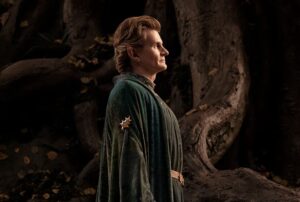
In the year 750 of the Second Age, Celebrimbor declared himself King of Eregion, a small and at the time sparsely-populated region in the foothills of the Misty Mountains west of Khazad-dûm. It may have seemed a strange decision to Gil-galad, but Celebrimbor had an ulterior motive that he appears not to have disclosed to anyone: like all Noldor Elves (and especially those of Fëanor’s house), he desired to make beautiful things with his hands, and he had heard rumors that the Dwarves of Khazad-dûm were in possession of Middle-earth’s sole vein of mithril, a precious metal that they had used to embellish their deep halls. He therefore befriended the Dwarves, and collaborated with the Dwarven smith Narvi to build a magical gate for Khazad-dûm’s west entrance, inlaid with mithril designs.
The Rings Of Power is probably set a few hundred years after the founding of Eregion, around the year 1600 of the Second Age (although Amazon is compressing the timeline to make it more manageable, so characters born thousands of years later are already alive and characters who ought to be alive are already dead, so don’t read too much into the exact date), at which point Celebrimbor would have built the city of Ost-in-Edhil and established the Gwaith-i-Mírdain, a guild of Elven jewelsmiths who would later go on to forge the Rings of Power with assistance from a stranger named Annatar. We’ve already caught glimpses of Celebrimbor’s study in promotional images; I just hope that before the end of season one, we get to see him and the Gwaith forge something.
Khazad-dûm
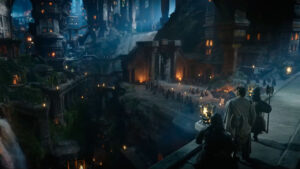
Roughly four-thousand years before the Fellowship of the Ring entered Khazad-dûm and found themselves hopelessly lost in its dark and unmapped ruins at the end of the Third Age, visitors to the Dwarven kingdom beneath the Misty Mountains would have feared no “holes and pitfalls” after stepping foot through the magical gates; for at the time, darkness had not yet fallen upon Khazad-dûm, nor had it earned the nickname of Moria, meaning “black chasm” in the Sindarin tongue of the Elves (although some may have already been using the moniker in a derogatory context regardless of what truth there was to it).
Khazad-dûm under the reign of King Durin III is a bustling hub of commerce located in the exact middle of Middle-earth with entrances on both sides of the Misty Mountains to allow for easier access to everybody – Noldor Elves from Eregion, Silvan Elves from Greenwood, Dwarves from the Blue Mountains to the Iron Hills, Harfoots from Wilderland, and Men from across the entire southern half of the map as far as the isle of Númenor. Ironically, even after receiving Rings of Power, the Dwarves were never again as powerful as they were in these days. Their reserves of mithril dwindled in the Third Age, prompting the Dwarven miners under the reign of King Durin VI to dig deeper in search of hidden mithril veins that could revitalize Khazad-dûm’s dying economy…but instead they awoke an ancient horror that had long slept coiled around the base of Caradhras, a Balrog of Morgoth known to the Dwarves of later years as “Durin’s Bane”, for it slaughtered the king and most of his people.
Amazon is compressing the timeline to such an extent that these events, which canonically didn’t occur until the year 1981 of the Third Age, might be depicted in a future season of The Rings Of Power, with Prince Durin IV, King Durin III’s son, taking the place of King Durin VI. At any rate, the eventual fall of Khazad-dûm is already being foreshadowed in the show’s trailers, the latest of which included a short sequence of a leaf falling through a series of caves and tunnels lined with mithril-veins before suddenly catching fire and disintegrating…followed almost immediately by a shot of a Balrog, which I guess could be any Balrog but certainly looks a hell of a lot like Durin’s Bane as portrayed in Peter Jackson’s Lord Of The Rings trilogy, with ram horns and a gaping maw emitting heat. All I’m saying is don’t get too attached to the Dwarven characters in The Rings Of Power…
Wilderland
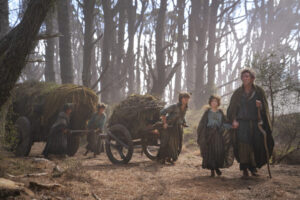
Everything that lies between the eastern foothills of the Misty Mountains and the western eaves of Greenwood (later Mirkwood), including the Anduin river valley, Dimrill Dale, Lórien, and the Gladden Fields, was known to the Hobbits of the late Third Age as “Wilderland” because it was a wild and unkempt corner of Middle-earth, but what they did not know (or no longer remembered) was that in the Second Age their ancestors lived in Wilderland along the west banks of the Anduin at least as far north as Rivendell and probably as far south as Khazad-dûm’s east gate. They were divided into three distinct subgroups, of whom the most numerous were the nimble Harfoots, a southerly subgroup who were friendly with Dwarves in ancient times.
The Rings Of Power follows a tightly-knit nomadic clan of Harfoots as they travel around Wilderland doing their level best to stay out of the affairs of Elves, Dwarves, and Men…which is peculiar for many reasons, one being that the Harfoots were canonically “the most inclined to settle in one place”. Of course, Amazon has been using the term Harfoot rather liberally, as if it applies to any and all prehistoric Hobbits, including the more adventurous Fallohides and the boat-building Stoors, which could be the only explanation we ever get for this apparent discrepancy – although I for one would be slightly disappointed if we never got to meet any true Stoors and Fallohides in future seasons.
I can understand why, in season one, Amazon wouldn’t want to overcomplicate matters by distinguishing between three different groups of Hobbits in a story that’s already straining to include Harfoots in the first place, but if The Rings Of Power follows the Harfoots on their great migration out of Wilderland and over the Misty Mountains (as I strongly suspect will be the case, given that we have to spend five seasons with them and they don’t have any relevance to the War of the Elves and Sauron), then it would make sense for them to run into Fallohides and Stoors at some point on that journey. Heck, throw in a pair of Fallohide brothers named Marcho and Blanco, and you have yourself a whole Shire origin story just waiting to be told…because that’s definitely something people are clamoring to see.
Tirharad
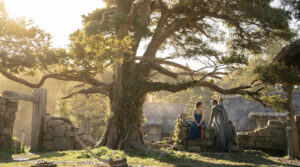
The only non-canonical location on this list, Tirharad or “south-watch” in Sindarin, appears to be a small village located somewhere in the Southlands of Middle-earth where humans whose ancestors worshiped Morgoth during the First Age were exiled to live out their days under the surveillance of Silvan Elves. The whole situation is very unusual. For one thing, we don’t know who exiled these people to begin with; I’m assuming they were a Noldor Elf, someone who would bear a grudge against all of Morgoth’s followers, but then who or what gave them the authority to command humans and why would they entrust the responsibility of surveilling these humans to Silvan Elves, those least affected by Morgoth? I’m very confused.
Several-hundred years later, most of the inhabitants of Tirharad have probably forgotten Morgoth’s name entirely, but at least one Silvan Elf, by the name of Arondir, remains in the nearby watch-tower to guard against future threats – although as he falls in love with a human woman named Bronwyn, he begins to realize that the threat to Tirharad is far greater than the threat its people pose to him. Tirharad is the site of several action sequences we’ve seen in the trailer, including a one-on-one fight between Bronwyn and an orc intruder, an epic confrontation between Arondir and a legion of orcs led by the mysterious “Adar”, and what is presumably the climactic battle of season one, in which Galadriel and a Númenórean army led by Tar-Míriel are involved in liberating the village from orcs.
Númenor
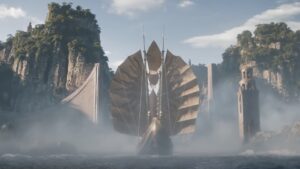
Situated in the middle of the Sundering Seas between Valinor and Middle-earth, the star-shaped island of Númenor juts suddenly out of the water, its irregular geography and sheer cliffs a testament to the strange, violent manner of its birth – lifted straight out of the ocean depths by Ulmo, god of the sea, while the earth was still pliable following the War of Wrath, to be a new homeland for humans who had fought alongside the Elves throughout the First Age. Following a star, these “Elf-friends” ventured across the ocean in a fleet of ships to find their island prepared for them, and visitors from Valinor already waiting for their arrival with gifts including plants, flowers, and songbirds.
Over the next thousand years, the Númenóreans enjoyed peace and prosperity under the leadership of wise, long-lived kings and queens who were initially sympathetic to the plight of the Elves in Middle-earth and as resistant to Sauron as their ancestors were to Morgoth. Since they were forbidden to travel west to Valinor and visit their friends, they sailed east and south along the shores of Middle-earth in search of new lands where they could satisfy their thirst for adventure. Along the way, they liberated many humans from the dominion of Sauron and demanded little in return save for wood with which to build larger ships.
But as time went on and the Númenórean mariners found themselves revisiting lands they had already explored, their eyes turned westward once more and they became gradually convinced that something in Valinor was being withheld from them, namely the gift of immortal life that was granted to all Elves. And as their curiosity gave way to wariness and thence to suspicion, they became…less kind. Canonically, it was in the year 1700 of the Second Age, during the reign of Tar-Minastir, that the Númenóreans first sent troops to Middle-earth to aid King Gil-galad in the wars against Sauron and were so impressed by their own military prowess that they began wielding the same violent force on the people under their protection in the hopes it would make them feel powerful.
Amazon is tweaking the timeline so that all of this (and a great deal more) will occur during the lifespan of Tar-Míriel, the last Queen of Númenor, who canonically lived between 3117 and 3319 of the Second Age. Tar-Míriel is still Tar-Míriel, and will still do everything that Tar-Míriel actually did in her lifetime…she just so happens to also fill the role of Tar-Minastir by leading the Númenórean armies to Middle-earth shortly before the forging of the Rings of Power, and I suspect that the characters around her, particularly non-canonical characters, will similarly play a variety of parts that Tolkien assigned to a multitude of thinly sketched-out characters across the sprawling narrative of the Second Age because he was writing a timeline, not a television series.
To cite one example, Isildur is a Númenórean mariner in The Rings Of Power so that we may witness the rapid evolution of the mariners from explorers to colonizers through his eyes, whereas if Amazon had opted to adapt the stories of the Second Age as written, with obligatory time-jumps between seasons to cover the entire three-thousand year period, we’d need to meet several different Númenórean mariner protagonists over the course of five seasons to tell the same story, and I can see where that would get redundant. Personally, I’m still a proponent of the anthology approach and would very much have liked to see that show, but I trust that The Rings Of Power‘s showrunners and writers can convey with a limited number of characters existing simultaneously to each other what Tolkien only managed with multiple characters existing at different points on a timeline of epic proportions.
Armenelos
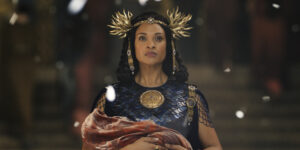
I’ve talked about Númenor, but said nothing yet of its capital city – Armenelos, possibly the greatest city in all of Middle-earth at the time, rivaled in size and splendor only by Khazad-dûm. Interestingly, the name Armenelos isn’t written in The Lord Of The Rings or its appendices, so Amazon shouldn’t be able to use it…but they already have, on the official map of Middle-earth they released way back in February of 2019 to promote The Rings Of Power before the series even had a title. It’s not even the only place-name on that map that comes to us from The Silmarillion or Unfinished Tales, but it’s a location we know for a fact we’ll visit in season one because we’ve already seen images of the city, so it would be really weird if Amazon just never uses the name in the show.
In fact, they wouldn’t be allowed to refer to any of the places on their own official map of Númenor by name without apparently overstepping their agreement with the Tolkien Estate, unless (as I’ve long suspected) they got more out of the agreement than just The Lord Of The Rings and its appendices (well, we know they also got The Hobbit, but that’s not gonna be much help to them in this case). Even the map of Númenor that John Howe must have been tracing from when he designed Amazon’s map of Middle-earth is only found in Unfinished Tales. And I promise this is relevant, because there are several stories and characters that Amazon could only use if they had the rights to Unfinished Tales – a notable example being Annatar, a familiar name to many Tolkien fans but one which never appeared in The Lord Of The Rings.
Oddly, a couple of place-names didn’t make it onto Amazon’s map and one of those is Andúnië, the city where Elendil and his family lived near the end of the Second Age – which leads me to believe that they’re being relocated to Armenelos for budgetary purposes in season one. Of the two coastal cities that did make the cut, Romenna is the city I believe was depicted in the opening shot of the first teaser trailer and in many subsequent trailers; it is also the seaport from which Tar-Míriel and her navy will likely set sail for Middle-earth, due to the city’s close proximity with Armenelos and eastward-facing harbor.
Honorable Mentions:
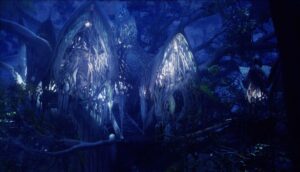
Amon Lanc, another name from Unfinished Tales that appeared on Amazon’s official map, this one referring to the tall bald hill rising out of southern Greenwood where the Silvan Elves under King Oropher (and later Oropher’s son, Thranduil – yes, that Thranduil) dwelt throughout the Second Age, before a shadow fell upon the forest and forced them to relocate northwards. Amon Lanc then became known as Dol Guldur.
Himling, Tol Fuin, and Tol Morwen, a string of islands off the northwestern coast of Middle-earth that remained above sea-level after Beleriand was submerged. I’m not sure if The Rings Of Power intends to take us to any of these islands, but their presence on Amazon’s official map is intriguing seeing as only Himling has ever previously appeared on maps of Middle-earth included in The Lord Of The Rings. Tol Fuin, the remnants of the Dorthonion highlands where Galadriel’s brothers Angrod and Aegnor dwelt throughout the First Age, could be significant if certain leaks are to be trusted…
Lond Daer, a Númenórean seaport and colony in Middle-earth founded by the great mariner Aldarion sometime between 750 and 800. Pelargir and Umbar, two seaports constructed later in the Second Age which gradually supplanted Lond Daer in significance and were absorbed into the empire of Gondor, do not appear on Amazon’s official map.
Lórien, or Lórinand as it was likely still being called in the Second Age, is the forest east of Khazad-dûm that canonically became Galadriel’s domain during the Second Age, although when exactly and how soon after Celebrimbor founded Eregion remained a mystery even to Tolkien. The conspicuous absence of Galadriel’s husband Celeborn in The Rings Of Power promotional materials has led some to theorize that Celeborn is already settled in Lórien waiting around for Galadriel throughout season one.
Which of these locations are you most excited to see onscreen, either for the first time in years or for the first time ever, when The Rings Of Power premieres next month? Share your own thoughts, theories, and opinions, in the comments below!
